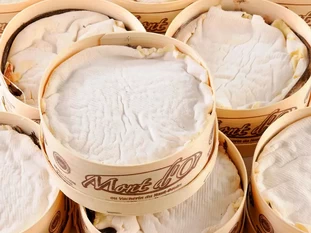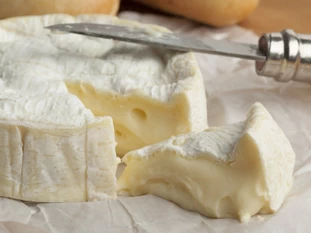Cutting soft cheeses

As you may have already noticed, when you have to use a "soft" cheese in a recipe - their exact name is "soft cheese" - such as Camembert, Munster or Mont d'or, it's not easy to make anything other than thick slices.
9,536 5/5 (2 reviews)
Keywords for this post:CheeseStuffCutCrustDecrustSoftColdSoft pasteLast modified on: February 20th 2024
Cutting soft cheeses
Well, yes, you can, with small cubes for example, but unfortunately you run the risk of obtaining a kind of cheese purée...
It's quite normal though, with this kind of cheese, unlike Comté for example, the center is very tender, and so is the rind, which is usually eaten (yes, it's a question of taste too).
So with these "soft" cheeses, it's impossible to cut them properly?
Well, normally not, but there's a very simple trick.
The trick is to put the cheese in the freezer for 1 or 2 hours, depending on its size. Say 1 hour for a cheese like camembert or saint-marcellin, and more like 2 hours for a cheese like mont d'or.
At the end of this time, the cheese has hardened, but is not frozen, so it can be cut much more easily.
This is particularly effective if you need to decrust (remove the rind from a cheese), which is normally almost impossible, but after this passage in the cold becomes perfectly feasible.
Be careful not to freeze the cheese completely, as this time it would be almost impossible to cut as it would be too hard.
The best thing to do is put it in the freezer for 1 hour to start with, then come and feel around to see if it has firmed up sufficiently. If not, go back for another 30 minutes or 1 hour, and so on until you reach the right texture.
Once you've finished cutting the cheese, you'll need to let it come back to temperature, unless you're going to cook it afterwards, in which case there's no need.
To sum up: to be able to cut a soft cheese, nothing beats a little time in the freezer to firm it up.
It's quite normal though, with this kind of cheese, unlike Comté for example, the center is very tender, and so is the rind, which is usually eaten (yes, it's a question of taste too).

So with these "soft" cheeses, it's impossible to cut them properly?
Well, normally not, but there's a very simple trick.
The trick is to put the cheese in the freezer for 1 or 2 hours, depending on its size. Say 1 hour for a cheese like camembert or saint-marcellin, and more like 2 hours for a cheese like mont d'or.
At the end of this time, the cheese has hardened, but is not frozen, so it can be cut much more easily.
This is particularly effective if you need to decrust (remove the rind from a cheese), which is normally almost impossible, but after this passage in the cold becomes perfectly feasible.

Be careful not to freeze the cheese completely, as this time it would be almost impossible to cut as it would be too hard.
The best thing to do is put it in the freezer for 1 hour to start with, then come and feel around to see if it has firmed up sufficiently. If not, go back for another 30 minutes or 1 hour, and so on until you reach the right texture.
Once you've finished cutting the cheese, you'll need to let it come back to temperature, unless you're going to cook it afterwards, in which case there's no need.
To sum up: to be able to cut a soft cheese, nothing beats a little time in the freezer to firm it up.
Lasts posts
Butter vs. grease
We often read in a recipe where a pastry is put into a mould that, just before pouring, the mould should be buttered or greased. But what's the difference between these 2 terms?December 1st 20251,2245
Getting out of the fridge early
Very often when you're cooking, you need to take food or preparations out of the fridge, to use them in the recipe in progress. There's nothing tricky about this: you just take them out of the fridge and use them, usually immediately, in the recipe. But is this really a good method?November 24th 20251,2125
Who's making the croissants?
When you look at a bakery from the outside, you naturally think that in the bakery, the bakers make the bread, and in the laboratory, the pastry chefs make the cakes. It's very often like that, with each of these professions having quite different ways of working, but sometimes there's also one...November 23th 20251,106
Oven height
When we put a dish or cake in the oven, we naturally tend to put it on the middle shelf, and that's what we usually do. But in some cases, this position and height can be a little tricky, so let's find out why.October 8th 20253,0235
The importance of sieving
In recipes that use a fine powder (flour, powdered sugar, etc.), you'll often see the advice to sift before using it. To sift is to pass the powder in question through a sieve (a very fine strainer) before incorporating it into your recipe. It's often advice, but is it really useful?September 3rd 20257,7223
Other pages you may also like
What is the difference between bakery and patisserie?
This is a question that you may well have asked yourself and which I will attempt to answer. In France the two trades of "boulangerie" (bakery) and "pâtisserie" (patisserie and confectionery) have always been quite distinct, but where exactly do the boundaries lie? .February 7th 2017134 K 14.1
The super powers of cornstarch
I start this new year by evoking an old product, that you most probably have in your cupboards, a white powder, often in a small cardboard package with a slightly outdated look, only the "gluten free" is relatively recent, it is simply cornstarch, hence its name of maïzena. It's used for a lot...January 14th 202215 K
The return of the "Norman hole"
You maybe know the "trou normand", this old gastronomic custom typically French which consists in taking a (small) glass of calvados, generally between the last course and the dessert? It's something that seems a bit anachronistic nowadays, having a glass of an alcohol of more than 60° in the...December 18th 202115 K4.8
Perpetual stock
It's something you have probably have done yourself: cooked or pre-cooked vegetables before adding them to a recipe. This is almost always done the same way: peel the chosen vegetables (carrots, for example), cut them up, boil them in salted water (using a tablespoon or so of coarse salt per litre),...November 22th 201631 K5
Egg yolks and caster sugar
We often come across recipes where we need to mix egg yolks with caster sugar. This would appear to be a very ordinary and simple thing to do but, be warned, these two ingredients can behave oddly together.February 15th 201883 K 24.3
Post a comment or question
Follow this page
If you are interested in this page, you can "follow" it, by entering your email address here. You will then receive a notification immediately each time the page is modified or a new comment is added. Please note that you will need to confirm this following.
Note: We'll never share your e-mail address with anyone else.
Alternatively: you can subscribe to the mailing list of cooling-ez.com , you will receive a e-mail for each new recipe published on the site.









